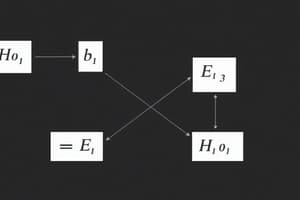Podcast
Questions and Answers
Which of the following statements accurately describes a proposition in propositional logic?
Which of the following statements accurately describes a proposition in propositional logic?
- A proposition is an opinion that may be arguable depending on the context.
- A proposition is a command that instructs someone to perform an action.
- A proposition is a declarative sentence that can be definitively classified as either true or false, but not both simultaneously. (correct)
- A proposition is a question that requires an answer demonstrating an understanding of a concept.
Which of the following mathematical statements can be classified as a proposition?
Which of the following mathematical statements can be classified as a proposition?
- $a > b$, where $a$ and $b$ are variables.
- What is the value of $x$ in the equation $2x = 4$?
- $520 < 111$ (correct)
- $x + y = 10$, where $x$ and $y$ are undefined variables.
Which of the following best illustrates the Law of Excluded Middle?
Which of the following best illustrates the Law of Excluded Middle?
- A statement is either true or false; there is no middle ground. (correct)
- If a statement is true, then it is true.
- Every statement has a corresponding contradiction.
- A statement cannot be both true and false.
Identify which of the following is NOT a basis for propositional logic?
Identify which of the following is NOT a basis for propositional logic?
Which of the following examples violates the Law of Non-Contradiction?
Which of the following examples violates the Law of Non-Contradiction?
Which of the following statements is a tautology?
Which of the following statements is a tautology?
Given the statement $(p \rightarrow q) \land p$, under what condition is this statement true?
Given the statement $(p \rightarrow q) \land p$, under what condition is this statement true?
Which of the following is a contradiction?
Which of the following is a contradiction?
Determine which statement is a contingency.
Determine which statement is a contingency.
Which of the following logical statements is equivalent to $p \rightarrow q$?
Which of the following logical statements is equivalent to $p \rightarrow q$?
Assuming p is TRUE and q is FALSE, what is the truth value of $(p \land q) \lor (\neg p \rightarrow q)$?
Assuming p is TRUE and q is FALSE, what is the truth value of $(p \land q) \lor (\neg p \rightarrow q)$?
If the statement $p \rightarrow q$ is FALSE, which of the following must be true?
If the statement $p \rightarrow q$ is FALSE, which of the following must be true?
Which of the following statements is logically equivalent to $\neg (p \lor q)$?
Which of the following statements is logically equivalent to $\neg (p \lor q)$?
Which logical equivalence law states that a proposition conjoined with TRUE is equivalent to the proposition itself?
Which logical equivalence law states that a proposition conjoined with TRUE is equivalent to the proposition itself?
According to De Morgan's Laws, what is the equivalent of $\neg (p \lor q)$?
According to De Morgan's Laws, what is the equivalent of $\neg (p \lor q)$?
Using replacement rules, which logical equivalence is correctly demonstrated?
Using replacement rules, which logical equivalence is correctly demonstrated?
If $p$ is 'It is raining' and $q$ is 'The ground is wet', which logical equivalence best represents the statement 'If it is raining then the ground is wet'?
If $p$ is 'It is raining' and $q$ is 'The ground is wet', which logical equivalence best represents the statement 'If it is raining then the ground is wet'?
Which law demonstrates the logical equivalence used to simplify the expression $p \land (p \lor q)$ to $p$?
Which law demonstrates the logical equivalence used to simplify the expression $p \land (p \lor q)$ to $p$?
Which of the following statements about logical equivalence is most accurate?
Which of the following statements about logical equivalence is most accurate?
Given the proposition $p \rightarrow q$, which of the following represents its contrapositive?
Given the proposition $p \rightarrow q$, which of the following represents its contrapositive?
What is the result of applying the double negation (involution) law to the statement 'It is not untrue that the sky is blue'?
What is the result of applying the double negation (involution) law to the statement 'It is not untrue that the sky is blue'?
Which logical connective results in a 'True' outcome only when both input propositions have the same truth value?
Which logical connective results in a 'True' outcome only when both input propositions have the same truth value?
Which of the following is logically equivalent to $\neg (p \land q)$?
Which of the following is logically equivalent to $\neg (p \land q)$?
Which of the following is logically equivalent to $p \rightarrow (q \rightarrow r)$ according to the Exportation Law?
Which of the following is logically equivalent to $p \rightarrow (q \rightarrow r)$ according to the Exportation Law?
Given the proposition 'If it is raining (p), then I am indoors (q),' which of the following represents the inverse?
Given the proposition 'If it is raining (p), then I am indoors (q),' which of the following represents the inverse?
According to Complement/Negation Laws, what is the result of $p \lor \neg p$?
According to Complement/Negation Laws, what is the result of $p \lor \neg p$?
According to the defined precedence of logical operators, which operation is performed first in the following expression: Øp Ù q Ú r?
According to the defined precedence of logical operators, which operation is performed first in the following expression: Øp Ù q Ú r?
Which of the following rules can be used to simplify the expression $(p \land q) \lor (p \land \neg q)$?
Which of the following rules can be used to simplify the expression $(p \land q) \lor (p \land \neg q)$?
If 'p' is 'True' and 'q' is 'False', what is the truth value of the compound proposition p Ú Øq?
If 'p' is 'True' and 'q' is 'False', what is the truth value of the compound proposition p Ú Øq?
Which logical equivalence is demonstrated by the statement: 'Saying (p and q) or r is the same as saying p and (q or r)'?
Which logical equivalence is demonstrated by the statement: 'Saying (p and q) or r is the same as saying p and (q or r)'?
If $p$ is 'The sun is shining' and $q$ is 'It is raining', how would you represent 'The sun is not shining and it is raining'?
If $p$ is 'The sun is shining' and $q$ is 'It is raining', how would you represent 'The sun is not shining and it is raining'?
Which of the following expressions is a tautology?
Which of the following expressions is a tautology?
What law is applied when simplifying $(p \land q) \land r$ to $p \land (q \land r)$?
What law is applied when simplifying $(p \land q) \land r$ to $p \land (q \land r)$?
Which logical connective is best suited to represent the statement: 'You can have cake or ice cream, but not both'?
Which logical connective is best suited to represent the statement: 'You can have cake or ice cream, but not both'?
According to logical equivalences, simplifying $p \lor T$ (where T represents TRUE) results in which of the following?
According to logical equivalences, simplifying $p \lor T$ (where T represents TRUE) results in which of the following?
What is the simplified form of $(p \rightarrow q) \land (p \land \neg q)$?
What is the simplified form of $(p \rightarrow q) \land (p \land \neg q)$?
Given the implication 'If x is divisible by 4 (p), then x is divisible by 2 (q)', which of the following is the contrapositive?
Given the implication 'If x is divisible by 4 (p), then x is divisible by 2 (q)', which of the following is the contrapositive?
Under what condition is the implication p®q considered false?
Under what condition is the implication p®q considered false?
Which logical connective is analogous to the intersection of sets in Venn diagrams?
Which logical connective is analogous to the intersection of sets in Venn diagrams?
What is a compound proposition?
What is a compound proposition?
Which logical connective represents the 'and' relationship between two propositions?
Which logical connective represents the 'and' relationship between two propositions?
What is the result of True Û False?
What is the result of True Û False?
Which of the following is the correct truth table row for p ® q when p is False and q is True?
Which of the following is the correct truth table row for p ® q when p is False and q is True?
Which logical operator has the highest precedence?
Which logical operator has the highest precedence?
In propositional logic, what is the purpose of a truth table?
In propositional logic, what is the purpose of a truth table?
Which connective is most closely associated with the idea of logical necessity or sufficient condition?
Which connective is most closely associated with the idea of logical necessity or sufficient condition?
Flashcards
Proposition
Proposition
A declarative sentence that is either true or false, but not both.
Law of Identity
Law of Identity
A fundamental principle stating that something is identical to itself (A is A).
Law of Excluded Middle
Law of Excluded Middle
Every proposition is either true or false; there is no middle ground.
Law of Non-Contradiction
Law of Non-Contradiction
Signup and view all the flashcards
Proposition Examples
Proposition Examples
Signup and view all the flashcards
Tautology
Tautology
Signup and view all the flashcards
Contradiction
Contradiction
Signup and view all the flashcards
Contingency
Contingency
Signup and view all the flashcards
p Ú Øp Tautology Example
p Ú Øp Tautology Example
Signup and view all the flashcards
p Ù Øp Contradiction Example
p Ù Øp Contradiction Example
Signup and view all the flashcards
(pÚq) Ú [(Øp) Ù ( Øq)] Tautology Exercise
(pÚq) Ú [(Øp) Ù ( Øq)] Tautology Exercise
Signup and view all the flashcards
(pÚq) Ù [( Øp)Ù( Øq)] Contradiction Exercise
(pÚq) Ù [( Øp)Ù( Øq)] Contradiction Exercise
Signup and view all the flashcards
p ® Ø p Contingency Example
p ® Ø p Contingency Example
Signup and view all the flashcards
Compound Proposition
Compound Proposition
Signup and view all the flashcards
Logical Negation
Logical Negation
Signup and view all the flashcards
Logical Conjunction (AND)
Logical Conjunction (AND)
Signup and view all the flashcards
Logical Disjunction (OR)
Logical Disjunction (OR)
Signup and view all the flashcards
Logical Implication
Logical Implication
Signup and view all the flashcards
Converse
Converse
Signup and view all the flashcards
Contrapositive
Contrapositive
Signup and view all the flashcards
Inverse
Inverse
Signup and view all the flashcards
Logical Biconditional
Logical Biconditional
Signup and view all the flashcards
XOR (Exclusive OR)
XOR (Exclusive OR)
Signup and view all the flashcards
Negation of p
Negation of p
Signup and view all the flashcards
Conjunction of p and q
Conjunction of p and q
Signup and view all the flashcards
Disjunction of p and q
Disjunction of p and q
Signup and view all the flashcards
Implication of p and q
Implication of p and q
Signup and view all the flashcards
Precedence of Logical Operators
Precedence of Logical Operators
Signup and view all the flashcards
Replacement Rule
Replacement Rule
Signup and view all the flashcards
Logical Equivalence
Logical Equivalence
Signup and view all the flashcards
Contrapositive Equivalence
Contrapositive Equivalence
Signup and view all the flashcards
Logical Connective
Logical Connective
Signup and view all the flashcards
F (False)
F (False)
Signup and view all the flashcards
Identity Law (Conjunction)
Identity Law (Conjunction)
Signup and view all the flashcards
Identity Law (Disjunction)
Identity Law (Disjunction)
Signup and view all the flashcards
Commutative Law
Commutative Law
Signup and view all the flashcards
Associative Law
Associative Law
Signup and view all the flashcards
Distributive Law
Distributive Law
Signup and view all the flashcards
Complement Law
Complement Law
Signup and view all the flashcards
Idempotency Law
Idempotency Law
Signup and view all the flashcards
Domination Law
Domination Law
Signup and view all the flashcards
Involution / Double Negation
Involution / Double Negation
Signup and view all the flashcards
Study Notes
- A proposition is a declarative sentence that is either true or false, but not both.
Bases for Propositional Logic
- Propositional logic is based on three laws: the Law of Identity (or "Logical Identity"), the Law of Excluded Middle, and the Law of Non-Contradiction.
Propositional Game Examples
- Some examples of propositions include: "Elephants are bigger than mice," "520 < 111," "y > 5,"
- "Today is January 1 and 99 < 5," "Please do not fall asleep,"
- "If elephants were red, they could hide in cherry trees," and "x < y if and only if y > x."
Compound Proposition
- A new proposition is constructed by combining one or more existing propositions.
Logical Connectives
- Logical connectives are used to create compound propositions.
- Negation (¬ or !) reverses the truth value of a proposition.
- If p is false (0), ¬p is true (1), and if p is true (1), ¬p is false (0).
- Logical conjunction (^) is true only if both propositions are true.
- The truth table shows p ^ q is true (1) only when both p and q are true (1).
- Logical disjunction (v) is true if either or both propositions are true.
- p v q is false (0) only when both p and q are false (0).
- Implication (⇒ or →) is true in all cases except when p is true and q is false.
- p → q is false (0) only when p is true (1) and q is false (0).
Related implications
- Converse: p→q becomes q→p
- Contrapositive: p→q becomes ¬q→¬p
- Inverse: p→q becomes ¬p→¬q
- Bi-conditional (⇔ or ↔) is true only if both propositions have the same truth value.
- p ↔ q is true (1) when both p and q are true (1) or both are false (0).
- XOR or exclusive OR (+) is true when exactly one of the propositions is true.
- p ⊕ q is true (1) when either p is true (1) and q is false (0), or when p is false (0) and q is true (1).
Practice Exercise
- Express propositions in English sentences using negation, conjunction, disjunction, implication, and bi-conditional connectives
- p: It is raining, q: I am indoors
Precedence of Logical Operators
- The order of operations for logical operators from highest to lowest is:
- Negation (¬ or !)
- Logical Conjunction (^)
- Logical Disjunction (v)
- Implication (⇒ or →)
- Bi-conditional (⇔ or ↔)
Precedence of Logical Operators examples
- ¬¬p
- p ^ q
- p v q ^ r
- p ^ q ^ r ^ s
- p ^ q v r v s
- p ^ q → p v q
- p ⇔ q ⇔ r ⇔ s
Tautology
- A tautology is a statement that is always true, regardless of the truth values of its components.
- The statement p ∨ ¬p is a tautology
Contradiction
- A contradiction is a statement that is always false, regardless of the truth values of its components.
- The statement p ^ ¬p is a contradiction
Contingency
- A contingency is a statement that is neither a tautology nor a contradiction, meaning its truth value depends on the truth values of its components.
- The statement p → p is a contingency.
Logical Equivalence
- Logical equivalence means that two compound propositions have the exact same truth value in every model.
Laws of logical equivalence
- Identity: p ^ T = p, p v F = p
- Commutative: p ^ q = q ^ p, p v q = q v p
- Associative: p ^ (q ^ r) = (p ^ q) ^ r, p v (q v r) = (p v q) v r
- Distributive: p ^ (q v r) = (p ^ q) v (p ^ r), p v (q ^ r) = (p v q) ^ (p v r)
- Complement/Negation: p ^ ¬p = F, p v ¬p = T
- Idempotency: p ^ p = p, p v p = p
- Zero (0) and one (1)/Domination: p ^ F = F, p v T = T
- Involution/Double Negation: ¬¬p = p
- De Morgan's: ¬(p ^ q) = ¬p v ¬q, ¬(p v q) = ¬p ^ ¬q
- Absorption or Redundancy: p ^ (p v q) = p, p v (p ^ q) = p
- Implication: p → q = ¬p v q
- Exportation (aka Currying): (p ^ q) → r = p → (q → r)
Practice Exercise examples
- Two compound propositions p = ¬ ¬p are logically equivalent
- Two compound propositions ¬ (p V (¬«p > q) = ¬ p > ¬q are logically equivalent
Practice Exercise
- Show by the use of replacement rules that the two compound propositions below are logically equivalent
- p→q=¬q→¬p
- (p^q) ^ (q→ p) = F
Studying That Suits You
Use AI to generate personalized quizzes and flashcards to suit your learning preferences.




